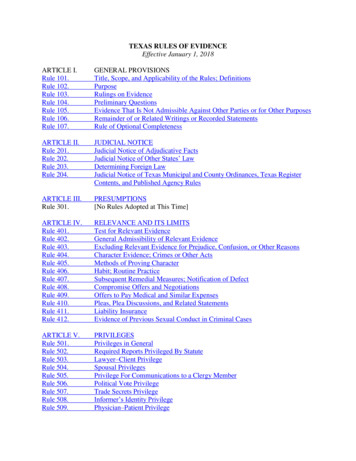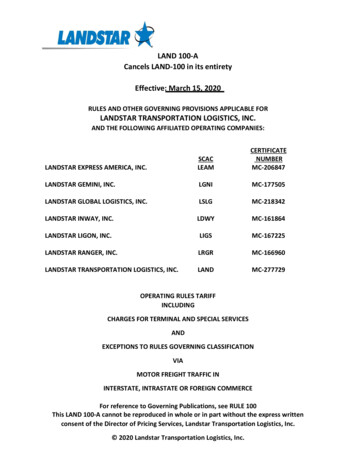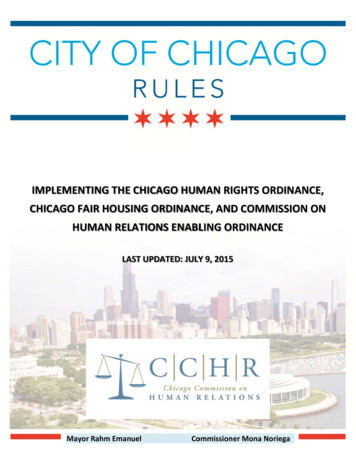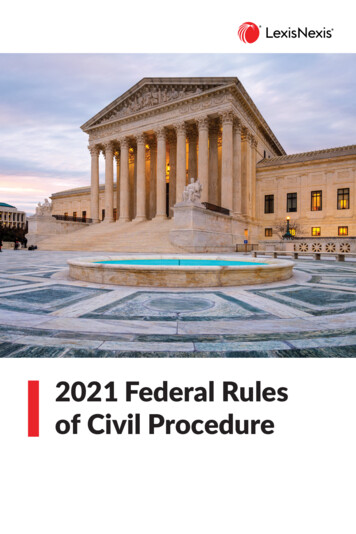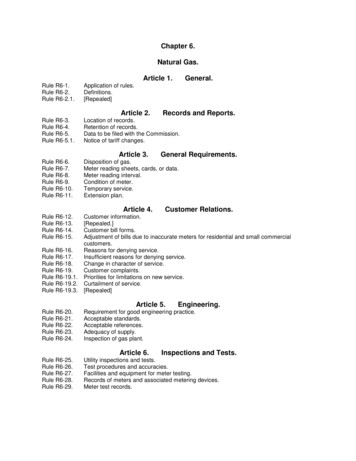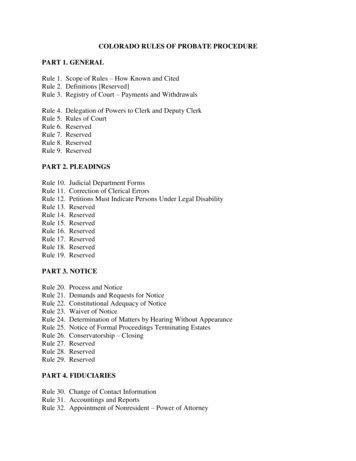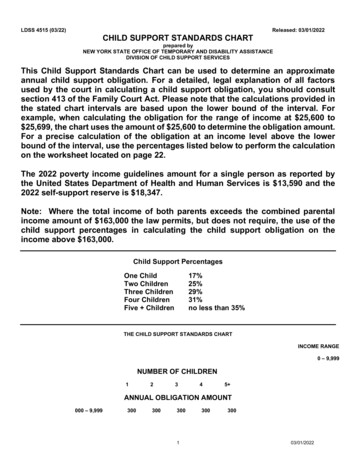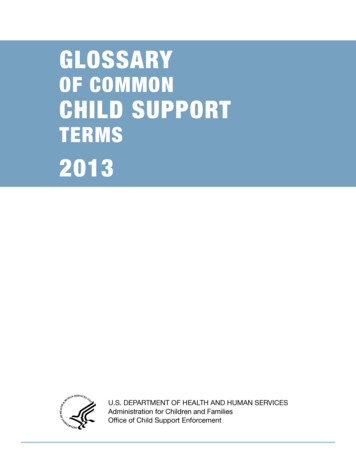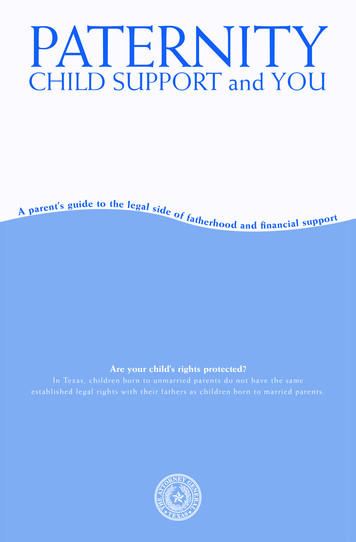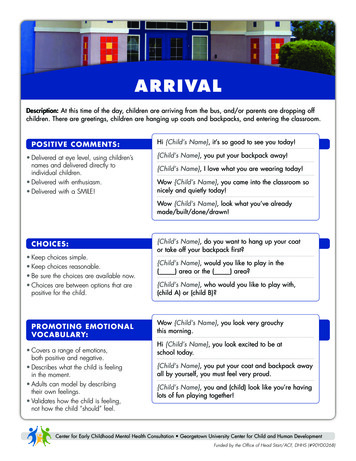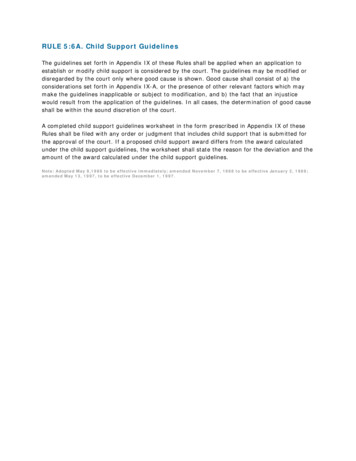
Transcription
RULE 5:6A. Child Support GuidelinesThe guidelines set forth in Appendix IX of these Rules shall be applied when an application toestablish or modify child support is considered by the court. The guidelines may be modified ordisregarded by the court only where good cause is shown. Good cause shall consist of a) theconsiderations set forth in Appendix IX-A, or the presence of other relevant factors which maymake the guidelines inapplicable or subject to modification, and b) the fact that an injusticewould result from the application of the guidelines. In all cases, the determination of good causeshall be within the sound discretion of the court.A completed child support guidelines worksheet in the form prescribed in Appendix IX of theseRules shall be filed with any order or judgment that includes child support that is submitted forthe approval of the court. If a proposed child support award differs from the award calculatedunder the child support guidelines, the worksheet shall state the reason for the deviation and theamount of the award calculated under the child support guidelines.Note: Adopted May 9,1986 to be effective immediately; amended November 7, 1988 to be effective January 2, 1989;amended May 13, 1997, to be effective December 1, 1997.
New Jersey Rules of Court Appendix IX-ACONSIDERATIONS IN THE USE OF CHILD SUPPORT GUIDELINES(Includes amendments through those effective May 1, 2015)1.Philosophy of the Child Support GuidelinesThese guidelines were developed to provide the court with economic information toassist in the establishment and modification of fair and adequate child support awards.The premise of these guidelines is that (1) child support is a continuous duty of bothparents, (2) children are entitled to share in the current income of both parents, and (3)children should not be the economic victims of divorce or out-of-wedlock birth. Theeconomic data and procedures of these guidelines attempt to simulate the percentageof parental net income that is spent on children in intact families. While it isacknowledged that the expenditures of two-household divorced, separated, or nonformed families are different from intact-family households, it is very important that thechildren of this State not be forced to live in poverty because of family disruption andthat they be afforded the same opportunities available to children in intact families withparents of similar financial means as their own parents.2.Use of the Child Support Guidelines As a Rebuttable PresumptionIn accordance with Rule 5:6A, these guidelines must be used as a rebuttablepresumption to establish and modify all child support orders. The guidelines must beapplied in all actions, contested and uncontested, in which child support is beingdetermined including those involving pendente lite (temporary) support, interstatesupport (Uniform Interstate Family Support Act (UIFSA)), domestic violence, foster care,divorce, non-dissolution, and public assistance (Temporary Assistance to NeedyFamilies or TANF). A rebuttable presumption means that an award based on theguidelines is assumed to be the correct amount of child support unless a party proves tothe court that circumstances exist that make a guidelines-based award inappropriate ina specific case. The guidelines may be disregarded or a guidelines-based awardadjusted if a party shows, and the court finds, that such action is appropriate due toconflict with one of the factors set forth in sections 4, 7, 10, 13, 14, 15 or 20 of AppendixIX-A, or due to the fact that an injustice would result due to the application of theguidelines in a specific case. The determination of whether good cause exists todisregard or adjust a guidelines- based award in a particular case shall be decided bythe court.3.Deviating from the Child Support GuidelinesIf the court finds that the guidelines are inappropriate in a specific case, it mayeither disregard the guidelines or adjust the guidelines-based award to accommodatethe needs of the children or the parents' circumstances. If the support guidelines are notapplied in a specific case or the guidelines-based award is adjusted, the reason for thedeviation and the amount of the guidelines-based award (before any adjustment) mustbe specified in writing on the guidelines worksheet or in the support order. Suchfindings clarify the basis for the support order if appealed or modified in the future. If theguidelines are found to be inapplicable in a particular case, the court should considerthe factors set forth in N.J.S.A. 2A:34-23 or N.J.S.A. 9:17-53 when establishing the child1
support award.4.The Income Shares Approach to Sharing Child-Rearing ExpensesNew Jersey statutes and case law provide that both parents are responsible forthe financial needs of their children. In intact families, the income of both parents ispooled and spent for the benefit of all household members including the children. Eachparent's contribution to the combined income of the family represents their relativesharing of household expenses. For example, if the parents have equal incomes, theyare assumed to share all expenditures for the family equally (50%). This same incomesharing principle is used to determine how the parents will share a child support award.In dissolved or non-formed families, however, the parents share only the expenses forthe child (i.e., the Appendix IX-F support schedules are based on the marginal or addedcost of a child or children to an adult couple). In sole-parenting situations, the custodialparent's share of the child-rearing expenses is assumed to be spent directly on the childthrough daily living expenses. The non-custodial parent's share of child- rearing costsrepresents the support order that is paid to the custodial parent for the benefit of thechild. In situations involving PAR Time (formerly referred to as visitation), both parentsmake direct expenditures for the child while the child resides in their homes. Toaccommodate duplicated and shifting expenses associated with a child who shares timewith parents who live separately, the Appendix IX-F sole-parenting awards may need tobe adjusted to reflect each parent's assumed level of marginal spending on the child.5.Economic Basis for the Child Support GuidelinesAt the foundation of the child support guidelines are estimates of what parents inintact families spend on their children. Determining the cost of raising a child is difficultbecause most goods and services purchased by families are shared by adults andchildren. Economists estimate that approximately 65% of household spending is forpooled items (e.g., a car, a washing machine, or a box of laundry detergent used incommon by all household members). Even for goods that are privately consumed (e.g.,clothing, food), expenditure surveys are not detailed enough to link individual householdmembers (adults or children) to a particular expenditure. Together, pooled and privatelyconsumed goods account for about 90% of total household expenditures. Since mostexpenditures on children cannot be observed directly, economists use an indirectmethod of determining child-rearing costs known as marginal-cost estimation. Marginalcost estimation attempts to find the added cost of a child to a family by comparing theexpenditures of families considered equally well-off economically and have differentnumbers of children. For example, if two families (one with and one without a child) areequally well-off, the additional expenses of the family with a child are assumed to be themarginal cost of the child.Selecting a Standard of Well-Being - Before estimating the marginal cost ofchildren, a standard of well-being must be defined. Different marginal cost estimationmethods use different standards of well-being. Although several standards have beenused in the past, no consensus has emerged as to which provides the most credibleresult. Two of the most widely used marginal-cost estimation methods, Rothbarth andEngel, employ the standards of well- being described below.2
Engel - The standard of well-being is the proportion of householdincome spent on food. Thus, if two families spend the same percentage oftheir income on food, they are considered equally well-off.Rothbarth - This standard of well-being is based on how parentsadjust their spending on adult goods due to the presence of a child. Inother words, well-being is measured by comparing excess-income (i.e.,after necessary expenditures for the family) available to purchase adultgoods such as adult clothing, alcohol, tobacco, and entertainment.Consumer Expenditure Data - Once an estimation technique is chosen, thehousehold expenditure data to which it is applied must be selected. Typically,economists use data from the Consumer Expenditure Survey (CEX). The CEX is themost detailed source of national data on household expenditures and how they vary byfamily composition, size, geographic location and socioeconomic characteristics. TheCEX collects expenditure information for hundreds of household consumption itemsincluding food, housing, clothing, transportation, education, child care, health care, andentertainment. The CEX is a cross-sectional survey designed to represent the civilian,non-institutional population in the United States. Approximately 5,000 familiesparticipate in the CEX each quarter. CEX results are published annually, however, theresults are generally three years old by the time they are available for public use. TheCEX is considered the best available source of information for determining the cost ofchildren using marginal-cost estimation techniques.The Betson Analysis - In September 1990, Dr. David Betson of the University ofNotre Dame published child-rearing estimates based on his analysis of pooled CEXdata from 1980 through the first quarter of 1987, a variety of estimation techniques, andalternative definitions of the standard of well-being. As did previous studies, Dr.Betson's analysis resulted in a wide range of estimates of expenditures on children. Dr.Betson, like other economists, believes that the true range of marginal expenditures onchildren lies at some interval between the Engel and Rothbarth estimates. The Engelestimates, which are close to per capita (i.e., equal shares), clearly overstate themarginal cost of children and, thus, represent the upper bound of spending on children.Economists know that the Engel estimates are incorrect, but do not have the sameinformation about the Rothbarth estimates. Thus, the Rothbarth estimates mayrepresent the true level of marginal spending on children or the theoretical lower boundof that spending. Dr. Betson concluded that the Rothbarth method produced the bestset of estimates on the marginal cost of children because it has the least empirical flawsand those that do exist have a minimal effect on the resulting estimates.Estimating Spending on Children - The CEX does not have a direct measure ofspending on children, so the expenditures on children are measured indirectly. The costof raising children is estimated by comparing total spending in households withoutchildren to total spending in households with one, two, and three children in all incomecategories covered by the tables. Although this may be an indicator of the marginal3
increase in household spending when children are added, it does not give a completepicture since income constraints may also force adults to spend less on themselves toshare what income is available with their child(ren). To measure the impact childrenmake on adult household spending, economists Michael and Lazear have ascertainedthat measuring the change in expenditures on adult clothing gives the best estimate ofexpenditures on children in the household. This particular "estimator," which is aderivative of the Rothbarth methodology adopted to current use by Dr. William Rodgers,III, Chief Economist of the John J. Heldrich Center for Workforce Development, EdwardBloustein School of Planning and Public Policy, at Rutgers University, is along with themarginal increases in overall household spending, analyzed to arrive at the overall costof child rearing as reflected in the awards table. The CEX data is also adjusted toaccount for the variety of educational levels, ethnic backgrounds, and other factorsspecific to the population of New Jersey.Development of Child Support Award Schedules - Dr. Rodgers' 2012 studyestimates parental expenditures on one, two, and three children as a percentage of totalhousehold outlays. To do this, Rodgers uses the estimation method developed in theLazear and Michael treatise (1988) and transforms the Rothbarth parameters into aschedule of child support obligations by using the following steps:a. converting child-related spending as a proportion of consumption to aproportion of net income;b. updating estimates to 2011;c. adjusting the schedule to reflect New Jersey's higher cost of living asmeasured by the "Consumer Price Index – All Urban Consumers"(CPI-U);d. deducting the cost of child care and unreimbursed health careexpenses that exceed 250 per child per year (these expenses areadded to the basic obligation);e. extrapolating the estimates to families with four, five, and six children;f. computing marginal proportions between income intervals so that thesupport schedule can be constructed in ten dollars increments;g. using the Rothbarth and marginal proportions to create the relationshipbetween support obligations and combined net weekly income; andh. using median regression to smooth (remove remaining kinks/discretejumps) the relationship.6.Economic Principles Included in the Child Support Guidelinesa. There is no absolute cost of raising children. The cost of raising children isinferred from the amount that parents' spend on their children. A child'smarginal cost is the amount of spending above what the parents would spendif they did not have a child.b. Larger households have lower per-person costs due to economies of scaleand the sharing of family goods (i.e., unit prices decrease as quantities andsharing increase).c. Total spending on children increases with family size but at a decreasing rate.Support awards increase with the number of children in the family.4
d. When a family's total outlays rise, child-related spending increases roughly inthe same proportion. In the Rodgers study's analysis, as one moves from thelowest to highest of the 22 income intervals, the average increase in totaloutlays is 7%, 6%, and 7% for one child, two children, and three children. Thecomparable average increases in the expenditures on children are 7%, 7%,and 9%.e. As a family's income increases, child-related expenditures increase becauseparents use a portion of their disposable income to improve their children'squality of life. From the Lazear and Michael model, the change (derivative) inchild-related expenditures with respect to family income has two components.The second portion of the derivative is the positive impact that income has ontotal expenditures.f. Child-related expenditures as a percentage of family consumption arerelatively constant across most of the income scale.g. As income increases, total family consumption spending declines as aproportion of net income since income items such as savings, personalinsurance, and gifts increase with family income. Families at lower level of theincome ladder have consumption spending that may exceed 100% of netincome. In contrast, high- income families may spend 60% to 75% of netincome on consumption items.h. As a family's income increases, child-related expenditures as a proportion offamily income decline, even though these expenditures as a percentage of afamily's consumption spending remain fairly constant. The difference betweenspending as a proportion of family income and a proportion of consumption isdue to the effect of income taxes, savings, and charitable contributions.Income allocated to these items is not available for consumption spending.i. Due to economies of scale, the sharing of family goods and the redistributionof adult spending, as the number of children increases, the additional cost ofeach child has a less than proportionate increase. Dr. Rodgers estimates thatchild-related expenditures for two children are less than twice as much aschild-related expenditures for one child. For two children, the average costacross the 22 income intervals is 1.7 more than one child. Also, the childrelated expenditures for three children are less than three times as much asone child. This study average is 2.2 more than one child. These estimates liein the range of those reported in the 2004 Policy Studies report for NewJersey.7.Assumptions Included in the Child Support Guidelinesa. Intact Family Spending Patterns as the Standard for Support Orders - Supportguidelines based on spending patterns of intact families provide an adequatelevel of support for children. Child-rearing expenditures of single parentsprovide little guidance for setting adequate child support awards since singleparent households generally have less money to spend compared with intactfamilies. The fact that single parents actually do spend less income onchildren compared with two-parent families does not mean that they shouldspend less if the other parent has the means to increase total spending on the5
children through support payments. Also, the level of spending by singleparents on their children has no relation to adequacy or the needs of thechildren but is a function of the total amount of income available to thoseparents.b. Standard of Living - Although these support guidelines attempt toapproximate the same level of marginal spending on children before divorceor separation, the resulting child support awards do not guarantee that thechildren's standard of living will remain the same if one of those eventsoccurs. Usually, the children's standard of living will decline since the childsupport award (based on marginal spending) is being added to a muchsmaller level of base household expenditures. Less total money is available inthe primary household of the child after divorce or separation since the otherparent's income is no longer available. Less money means a decline inhousehold expenditures which results in a lower standard of living.Additionally, some economies of scale are lost when one parent leaves thehousehold.c. Marginal-Cost Estimation - For determining child support obligations,marginal-cost estimation techniques, which provide the additional cost ofchildren based on intact- family spending patterns, are more appropriate thanaverage-cost methods that divide spending between all family membersequally (per capita).d. The Rothbarth Marginal Cost Estimator - The Rothbarth marginal costestimation techniques (e.g., Betson and Lazear and Michael) provide themost accurate estimates of parental expenditures on children in dual-parentfamilies. Dr. Rodgers' 2012 analysis of the 2000 to 2011 micro data of theConsumer Expenditure Survey provides the most current and reliableestimates of child-related expenditures in dual-parent families.e. National versus New Jersey Spending on Children - Because the Rothbarthestimates are for the U.S. and it is well known that New Jersey's incomedistribution is very different from the U.S income distribution, Dr. Rodgersuses U.S. Census data to equate the income of New Jersey and U.S familiesand constructs proportions to smooth the schedule or remove discrete jumpsin obligation as net income rises. This follows the same principle as in the2004 Policy Studies Report for New Jersey. The 2010 U.S. and New Jerseyincome distribution in the American Community Survey was used to adjustthe Rothbarth estimates.f. NCP/PAR Time- The awards in the support schedules represent spending onchildren by intact families. In an intact family, the children reside in onehousehold and no NCP/PAR Time is needed. This is similar to child supportactions in which one parent has sole physical custody of a child and there isno NCP/PAR Time. The awards in the Appendix IX-F support schedules6
represent situations in which the child is with the custodial parent 100% of thetime. Although the Appendix IX-F awards are not reduced for NCP/PAR Time,they may be adjusted, if these factors are present in a specific case, throughworksheet calculations. For further information and assumptions related toNCP/PAR Time adjustments and their related assumptions, see paragraphs13 and 14 respectively.g. Effect of a Child's Age - Dr. Rodgers' 2012 study does not provide estimateson child-rearing expenditures by children's age groups. The Appendix IX-Fawards represent the average cost of raising a child from age zero through 17years (i.e., the total marginal cost averaged over 18 years). Studies haveshown that expenditures are higher than the average for teen-aged childrenand lower than the average for preteen children.h. Self-Support Reserve - The self-support reserve is a factor in calculating achild support award only when one or both of the parents have income at ornear the poverty level. The self-support reserve is 105% of the U.S. povertyguideline for one person. It attempts to ensure that the obligor has sufficientincome to maintain a basic subsistence level and the incentive to work so thatchild support can be paid. A child support award is adjusted to reflect the selfsupport reserve only if payment of the child support award would reduce theobligor's net income below the reserve and the custodial parent's (or theParent of the Primary Residence's) net income minus the custodial parent'sshare of the child support award is greater than 105% of the povertyguideline. The latter condition is necessary to ensure that custodial parentscan meet their basic needs so that they can care for the children. As ofJanuary 22, 2015, the self-support reserve is 238 per week (this amount is105% of the poverty guideline for one person).i. Income Tax Withholding - For wage earners, income tax withholding ratesprovide an accurate estimate of after-tax income available to pay weeklysupport obligations. Income tax withholding may differ from end-of-year taxobligations due to the parent's filing status and the number exemptions,deductions and credits reported or claimed by each parent.j.Spending of Child Support Order - These guidelines assume that the obligeeis spending the support award for the benefit of the child or children.k. Sharing of Child-Rearing Expenses - These guidelines assume that theparents are sharing in the child-rearing expenses in proportion to their relativeincomes. To the extent that this is not true (i.e., if one parent is paying allcosts associated with housing for the child from his or her own income) andcan be proven to the court, a guidelines-based support award may requireadjustment.7
8.Expenses Included in the Child Support SchedulesThe awards in the Appendix IX-F child support schedules represent the averageamount that intact families spend on their children (i.e., the marginal amount spent onthe children). The Appendix IX-F support awards include the child's share of expensesfor housing, food, clothing, transportation, entertainment, unreimbursed health care upto and including 250 per child per year, and miscellaneous items. Specific itemsincluded in each category are listed below. Note: The fact that a family does not incur aspecific expense in a consumption category is not a basis for a deviation from the childsupport guidelines. The Appendix IX-F awards are based on the percentage of incomespent on children by a large number of families in a variety of socioeconomic situations.The use of averages reflects the diversity of spending by parents. To qualify for adeviation based on average costs, a parent must show that the family's marginalspending on children for all items related to a consumption category differs from theaverage family (e.g., there are no housing costs).Housing - Mortgage principal and interest payments or home equity loans,property taxes, insurance, refinancing charges, repairs, maintenance, rent,parking fees, property management or security fees, expenses for vacationhomes, lodging while out of town, utilities, fuels, public services, domesticservices, lawn care, gardening, pest control, laundry and dry cleaning (nonclothing), moving and storage, repairs on home, furniture, major appliances,purchase or rental of household equipment of tools, postage, laundry or cleaningsupplies, cleaning and toilet tissues, household and lawn products, stationary, allindoor and outdoor furniture, floor coverings, all small appliances andhousewares (except personal care appliances), all household textiles (e.g.,linens, drapes, slipcovers, sewing materials, etc.), and miscellaneous householdequipment (e.g., clocks, luggage, light fixtures, computers and software,decorating items, etc.). The net purchase price of a home is not included asexpenditures in this category.Food - All food and non-alcoholic beverages purchased for home consumption orpurchased away from home (including vending machines, restaurants, tips,school meals and catered affairs). Non-food items (e.g., tissue papers, alcoholicbeverages, cigarettes) are not included.Clothing - All children's clothing (including school uniforms), footwear (exceptspecial footwear for sports), diapers, repairs or alterations to clothing andfootwear, storage, dry cleaning, laundry, watches, and jewelry.Transportation - All costs involved with owning or leasing an automobile includingmonthly installments toward principal cost, finance charges (interest), leasepayments, gas and motor oil, insurance, maintenance and repairs. Also, includedare other costs related to transportation such as public transit, parking fees,license and registration fees, towing, tolls, and automobile service clubs. The netoutlay (purchase price minus the trade-in value) for a vehicle purchase is notincluded. Transportation also does not include expenses associated with a motor8
vehicle purchased or leased for the intended primary use of a child subject to thesupport order.Unreimbursed Health Care Up to and Including 250 Per Child Per Year Unreimbursed health-care expenditures (e.g., medical and dental) up to andincluding 250 per child per year are included in the schedules. Such expensesare considered ordinary and may include items such as non-prescription drugs,co-payments or health care services, equipment or products. The parent's costof adding a child to health insurance policy is not included in the schedules.Entertainment - Fees, memberships and admissions to sports, recreational, orsocial events, lessons or instructions, movie rentals, televisions, mobile devices,sound equipment, pets, hobbies, toys, playground equipment, photographicequipment, film processing, video games, and recreational, exercise or sportsequipment.Miscellaneous Items - Personal care products and services (e.g., hair, shaving,cosmetics), books and magazines, school supplies, cash contributions, personalinsurance, and finance charges (except those for mortgage and vehiclepurchases).Note: Tuition for children (i.e., for private, parochial, or trade schools, or othersecondary schools, or post-secondary education) are not included in the childsupport schedules and may be treated as a supplemental expense.9.Expenses That May Be Added to the Basic Child Support ObligationBecause some child-related expenses represent large or variable expendituresor are not incurred by typical intact families, it is not appropriate to include them in theAppendix IX-F basic child support awards. The items listed below are not included in theAppendix IX-F child support awards. If incurred in a particular case, these expensesshould be added to the basic support obligation.a. Child-Care Expenses - The average cost of child care, including day camp inlieu of child care, is not factored into in the schedules. The net cost (after taxcredits) of work-related child care should be added to the basic obligation ifincurred.b. Health Insurance for the Child - The parent's marginal cost of adding a childto a health insurance premium is not included in the support schedules andshould be added to the basic obligation if incurred.c. Predictable and Recurring Unreimbursed Health Care Expenses In Excess of 250 Per Child Per Year - Unreimbursed health-care expenses for a child inexcess of 250 per child per year are not included in the schedules. Suchexpenses should be added to the basic obligation if they are predictable andrecurring. Health-care expenses for a child that exceed 250 per child per9
year that are not predictable and recurring should be shared by the parents inproportion to their relative incomes as incurred (i.e., the sharing of theseexpenses should be addressed in the general language of the order orjudgment). Health care costs that are not included in the support awardshould be paid directly to the parent who made or will make the expenditureor directly to the provider of the health care (also, see N.J.S.A. 2A:34- 23b).d. Other Expenses Approved by the Court - These are predictable and recurringexpenses for children that may not be incurred by average or intact familiessuch as private elementary or secondary education, special needs of gifted ordisabled children, and visitation transportation expenses. The addition ofthese expenses to the basic obligation must be approved by the court. Ifincurred, special expenses that are not predictable and recurring should beshared by the parents in proportion to their relative incomes (i.e., the sharingof these expenses should be addressed in the general language of the orderor judgment). Special expenses not included in the award should be paiddirectly to the parent who made or will make the expenditure or to theprovider of the goods or services.10.Adjustments to the Support ObligationThe factors listed below may require an adjustment to the basic child supportob
If a proposed child support award differs from the award calculated under the child support guidelines, the worksheet shall state the reason for the deviation and the amount of the award calculated under the child support guidelines. Note: Adopted May 9,1986 to be effective immediately; amended November 7, 1988 to be effective January 2, 1989; .
